Introduction
By now it should be obvious that the responsibility of serving in the capacity of ground crew or wing runner is much more complex than simply running alongside the departing glider’s wing. The process of launching a glider is one of the most safety-critical aspects of the entire wing running operation and of the entire glider flight. Consequently, the wing runner must be familiar with all aspects of the launch sequence.
Once the towline has been checked for proper attachment to the glider and the wing runner has moved to a position at the wingtip of the glider, the pilot of the tow aircraft can begin to remove the slack from the towline once the proper signal has been given. The following sections describe the procedures to be used to safely remove slack from the towline in preparation for a glider launch.
Safety
The wing runner must recognize the hazard that exists once the towline is connected to the glider. If the pilot of the tow aircraft initiates the takeoff before the area around the glider is cleared of all ground crewmembers and spectators, serious injury can occur. To prevent this type of occurrence, ensure that no one is allowed to walk or stand between a taxying tow aircraft and the glider.
The most effective way to prevent this from hazarding the wing runner is to move out beyond the wingtip of the glider immediately after the towline is connected. By doing so, the wing runner will not be struck in the event of the glider being inadvertently moved forward. The wing runner should always consider the region in front of glider that has been connected to a towline, whether the launch is being made by ground or aero tow, to be a danger zone.

It is also important to realize that the tow pilot and the pilot of the glider have very limited rearward visibility and restricted forward visibility from the cockpit. They rely heavily on the wing runner to monitor the operation for potential hazards during the launch of the glider.
Sequence of Events
The sequence of events in this segment are:
- The wing runner clears the area around the glider of people and movable obstructions.
- The wing runner checks the glider canopy for security and that all external devices such as wing and tail dollies are removed. The wing runner should also confirm that the glider’s spoilers / divebrakes are closed.
- The wing runner checks the traffic pattern for conflicting traffic and ensures that the area ahead and to the sides is clear of obstructions. These include parked gliders, vehicles, spectators, and anything else that could constitute a collision hazard if the tow were to be aborted. [See the Note immediately below.]
- The wing runner should announce that the “pattern is clear” or point our conflicting traffic.
- Once the glider pilot has signaled appropriately, the wing runner gives the signal to the tow pilot to remove slack
- If necessary, the wing runner signals “hold” to indicate to the tow pilot to hold position.
Note: It must be kept in mind that in the event of a tow abort when the glider has not yet achieved full lateral or directional control, a dropped wing or uncommanded change in direction could result in the glider performing a “ground loop” – the out-of-control glider following a circular path (which could be several hundred feet in diameter, depending on the glider speed) off to one side or the other. The safe course is to ensure that there is an area clear of all obstructions ahead and to the side of the glider about to be towed. The size of this area depends on the circumstances, including the type of glider being towed, and the strength and direction of the wind. If in doubt, the wing runner should seek the advice of the glider pilot – he/she has the final decision.
Clear Area of People
Once the glider is connected to the tow aircraft, no persons other than the wing runner should be allowed near the glider, especially not within the DANGER ZONE. This is particularly true for personnel unfamiliar with the launch operations (i.e. friends or spectators taking photographs, etc.), as they may become distracted and not recognize the potential hazard.
Check Glider Configuration
Before proceeding with the launch operation, the wing runner should conduct a brief visual check of the glider to ensure that the canopy is secure, all external devices such as wing and tail dollies are removed, and the spoilers / divebrakes are securely stowed. Note: In some high performance sailplanes the takeoff is initiated with the spoilers extended for increased controllability. This procedure should be discussed with the pilot of the glider prior to takeoff if the wing runner and tow pilot are unfamiliar with the procedure. Any discrepancy noted should be immediately communicated to the pilot of the glider.
Check Traffic Pattern
Prior to giving the signal to Take Up Slack, the wing runner should visually scan the traffic pattern to ensure that the glider launch will not conflict with other aircraft on the runway or established in the pattern. The scan should include the traffic pattern to all existing runways at the facility being used as airborne traffic might not always use recommended traffic pattern procedures.
If an aircraft is observed in the traffic pattern and the glider is ready to launch, a decision must be made as whether the launch can be continued without causing a conflict with the landing aircraft. Under normal circumstances, it is usually better to discontinue the launch and clear the aircraft from the runway. If the launch was to proceed and a subsequent emergency causes the takeoff to be aborted, the pilot of the glider might have to make a landing in conflict with the other traffic. The preferable approach is to avoid the situation of conflicting traffic by maintaining a high level of awareness of potential conflicting traffic when conducting launch operations.
When it has been determined that the glider is ready to launch and the traffic pattern is clear, the wing runner should make visual contact with the pilot of the glider and announce, “Pattern Clear.” When the pilot of the glider is ready for the slack to be removed from the towline, a “Thumbs-up” signal is given by the pilot to indicate “Pilot Ready-Level Wings.” The wing runner should then level the wings of the glider. Even if the “Thumbs-up” signal has been given, the wings should not be leveled unless it is clear that there is no potential conflicting traffic. Note: This may involve a judgment call – if it is likely to be quicker to launch the glider than get it and the towplane clear of the runway, launching the glider could be the better course if there is insufficient time to otherwise get the runway clear before another glider needs to land on the runway.
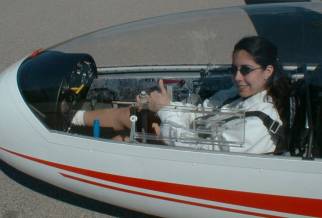
Launch Signals
After receiving a “Thumbs-up” signal from the pilot of the glider indicating “Pilot Ready-Level Wings,” the wing runner should level the wings of the glider to the takeoff position. The wings of the glider should never be raised before the “Pilot Ready-Level Wings” signal is received from the pilot of the glider, and only then when the wing runner has checked that it is safe for the launch to proceed.
Two hand signals are used during normal operations to communicate with the pilot of the tow aircraft. These signals are very important, as the tow pilot may have limited visibility of the area directly behind the tow aircraft. In this case, the tow pilot will rely on the wing runner to assist in the positioning of the tow aircraft to remove slack from the towline. The wing runner should always give the signals promptly and correctly to prevent the glider being lurched forward as the towline becomes taut.
Take Up Slack
The “Take Up Slack” signal is given to instruct the tow pilot to begin a slow taxi forward to remove slack from the towline. The wing runner signals the tow pilot to begin removing slack from the towline by moving one arm from side to side through an arc below the shoulder. Note: Throughout the process, the wing runner should be monitoring the rope for proper takeout of the slack, the glider for further signals, and the pattern for conflicting traffic – watching the towplane provides no useful information!

Hold
If necessary, the wing runner should signal the tow pilot to “Hold” position by lowering the wing of the glider and holding both arms outstretched to the side. The wing runner may initiate the hold signal when necessary without request from the pilot of the glider.
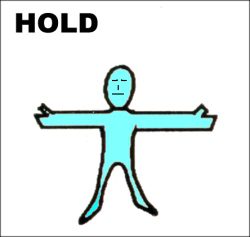
Note: At some soaring operations, the wingtip of the glider remains on the ground until the slack has been removed from the towline. Once the slack has been removed, the wing of the glider is raised and the “Begin Takeoff” signal is given. A complete briefing at the local soaring operation is vital to ensure safe launch operations. A number of hand and aircraft signals are used to communicate various conditions and intentions between the wing runner, glider pilot, and tow pilot.
The sequence and significance of these signals can vary between different glider operations, so you should receive a thorough briefing at any new operation before performing the wing running role there. Be particularly observant of the transfer of launch control between the wing runner and glider pilot. In some operations, once the glider pilot gives the “thumbs up” signal, the wing runner controls the rest of the launch. At other operations, the glider pilot retains control of the launch procedure and the wing runner is simply there to hold the wing and signal the glider pilot’s intentions to the tow pilot.

[Optional] Towplane Ready
The tow pilot will ensure that the traffic pattern is clear of aircraft. Once assured that the glider is ready and the departure path is clear, the “Towplane Ready” signal may be given with a waggle of the tow plane rudder.
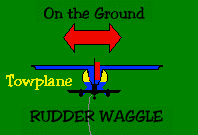
Begin Takeoff
When the glider pilot is ready for the takeoff roll, the glider pilot waggles the rudder and the wing runner (having made a final check to ensure that the pattern remains clear) signals with a circular motion of the arm.
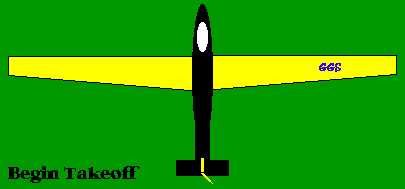
It is imperative not to give the “Begin Takeoff” signal unless the glider pilot is ready. Always wait for the glider pilot to give the rudder waggle before giving the “Begin Takeoff” arm motion.

Note: Throughout the process, the wing runner has the continuing responsibility of ensuring that there is no conflicting traffic. Neither the tow pilot nor the glider pilot has a clear view of the pattern – they depend on the wing runner’s assistance to do this. If a potential conflict is identified, the launch should be stopped and, if appropriate, the glider and tow plane moved clear of the launch area. Sometimes this calls for exercise of judgment – in some circumstances it may be safer for the tow to proceed and clear the area. An example of this might be where there is only one landing area, blocked by the glider and towplane waiting to launch, with a glider in the latter stages of its approach, leaving insufficient time to push the glider and move the towplane off the runway. If in doubt, don’t launch, inform the glider pilot – he/she has the final decision.
Running the Wing
When the ground roll begins, the wing runner should run alongside the glider and keep the wings level (i.e. parallel with the ground) until the glider pilot gains control authority. It is important when running the wing to hold it lightly to allow the glider pilot to have full control authority as soon as possible. Care should be taken not to push or pull on the wingtip, as this may have a negative effect on the pilot’s directional control of the glider.
Release the wing as soon as the glider is capable of maintaining wings level. In a strong headwind, this may occur in a few short steps. The opposite is true when launching with a tailwind. The wing runner must be prepared to run fast for a longer distance. The same will be true when the glider is operating at an increased weight due to the addition of water ballast in its wings. In this case, the pilot will not have sufficient aileron control to maintain a wings level attitude until the glider achieves a slightly higher speed.
Often the glider pilot will inadvertently hold some non-neutral aileron position during the initial ground roll. If the wing runner continues to hold the wing level against the resulting wingtip pressure, the glider will tend to drop a wing as soon as it is released. Instead, yield to the wingtip pressure and permit the wing to rise or fall slightly in accordance with the pressure. The glider pilot will then instinctively remove the inadvertent aileron control input.
When launching in a crosswind, it is important to keep the wing level or slightly down on the into-wind side. If the wing is permitted to rise, it may be impossible for the glider pilot to restore a wing-level condition and the launch must be aborted.
The wing runner should be aware of the difference in glider behavior when using nose and CG tow hitches. Nose-mounted tow hitches permit some restoring force if the glider begins to point away from the tow plane but this force is negligible when using CG-mounted tow hitches. The wing runner must be particularly diligent when launching a glider with a CG tow hitch in a crosswind. For the first several feet of the ground roll, the glider pilot has minimal directional control authority and any swing of the glider will require an immediate launch abort by the pilot.
Watch this short movie on wingrunning. MPG 8 MB
Emergency Signals
The following signals should be used when a hazardous condition is recognized.
Stop Engine/Release Towline
This signal is given to the glider pilot to command a release of the towline prior to launch. For the tow pilot, the signal is used to initiate a release of the towline and/or to command the tow pilot to stop the engine of the tow plane. This signal is given by moving a hand back and forth across the throat.
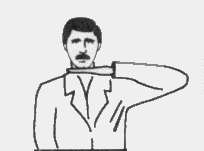
Stop Engine/Release Towline
This signal is given to the glider pilot to command a release of the towline prior to launch. For the tow pilot, the signal is used to initiate a release of the towline and/or to command the tow pilot to stop the engine of the tow plane. This signal is given by moving a hand back and forth across the throat.

Stop Operation or Emergency
The signal to stop operation is made by waving the arms back and forth above the head in a swift manner. The pilot of the glider may stop the launch operation at any time by releasing the towline. Before giving the signal, it is necessary to replace the glider’s wing on the ground. This should direct the tow pilot’s attention to the signal being given by the wing runner.
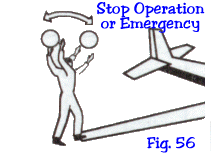
This signal is distinct from the “hold” signal that is associated with normal operations. If the “stop operation” or “emergency” signal is given, the wing runner should anticipate rapid action by the tow plane including the tow pilot releasing the towline and taxiing clear of the active runway.
Clearing the Launch Area
After the glider has been launched, the wing runner should survey the area for tail dollies, ballast, tow ring adapters, rope hooks or any other equipment that may pose a hazard for subsequent launches. These items should be removed from the launch area. Be particularly aware of landing aircraft when clearing the launch area and returning equipment to the operations base.
Summary
- Be aware of the hazards that exist when the glider is connected to the towline and remain clear of the DANGER ZONE in front of the glider’s wing.
- Perform a final visual check of the glider canopy, spoilers / divebrakes, and external attachments. Do not allow the launch to continue if any discrepancies are noted.
- Visually check the area ahead for obstructions and the traffic pattern to all runways for conflicting traffic and be prepared to discontinue the launch if required.
- Give the “Take Up Slack” and, if necessary the “Hold” signals to control the tow plane prior to takeoff.
- Always give the appropriate signals in an accurate and timely manner.
- Maintain high situational awareness and communicate any significant information to the pilot of the glider.
- Be prepared to abort the launch at any time if it is determined that continuing it would pose a hazard.
- Give the appropriate signals to the glider pilot and tow pilot. Remember that the pilot of the glider is the final authority in controlling the launch operation.
- When running the wing, hold it lightly to permit the glider pilot to feel the forces acting upon the glider.
- Be particularly sensitive to a rising or falling wing due to inadvertent control deflections by the glider pilot.
- When launching a glider in a crosswind, hold the upwind wing level or slightly low. Be particularly vigilant when launching CG-hook equipped gliders in a crosswind.
- Clear the launch area of any items left behind.
- Understand the difference between the “emergency” or “stop operation” signal and the “hold” signal.


